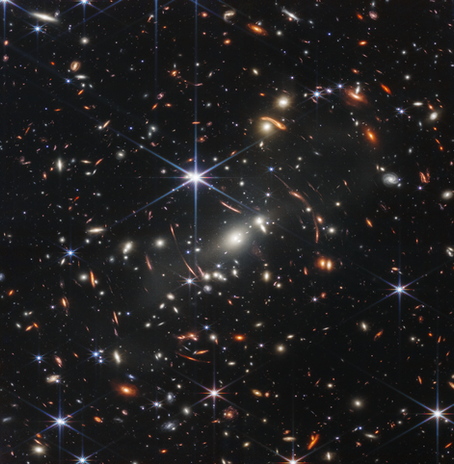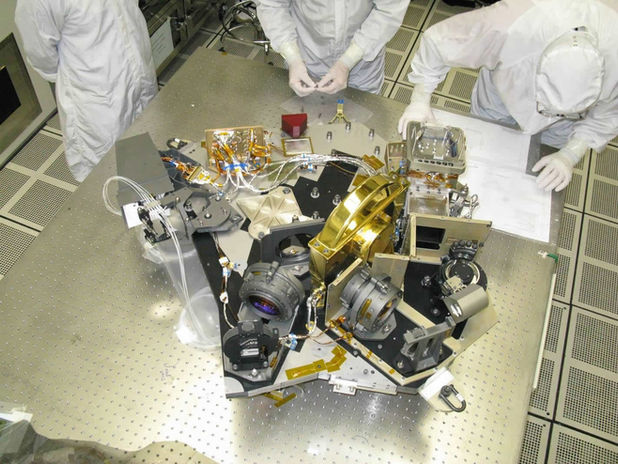

Southern Ring Nebula, JWST, NASA
In a chorus of jubilant cries, NASA’s $10 billion telescope secured a spot among the stars after several decades of construction.
The James Webb Space Telescope, named after a former NASA administrator, was initiated in 1996 and launched on Dec. 25, 2021. It is the closest scientific development to a time machine; by utilizing infrared technology, it aims to observe the formation of early galaxies.
Achieving this task is no small feat. James Webb has four major components that enable it’s sharp deep-space imagery: the Near Infrared Camera (NIRCam), the Near Infrared Spectrograph (NIRSpec), the Mid Infrared Instrument (MIRI), and the Fine Guidance Sensors (FGS).
3D Model Credit: NASA
Each instrument depends on infrared to function, a light composed of wavelengths that exist beyond the visible section of the electromagnetic spectrum. Humans experience these wavelengths as heat. However, James Webb makes them accessible to the eye — infrared’s lower frequency allows it to penetrate space dust for a clearer picture.
Oh, cool. Another Hubble Space Telescope? Not exactly.
According to NASA’s Infrared Astronomy exploration, the Hubble Space Telescope can read 90-2,500 nanometers of light. In comparison, James Webb reads 600-28,500 nanometers. This extended perceptibility translates to clearer imagery and a telescope that can see through previously impenetrable conditions.
It’s no secret that space exploration has an internationally competitive past. “The Space Race” and conflict between the United States and Soviet Union will be forever ingrained in our country’s history.
That being said, James Webb is turning over a new, more cooperative, leaf. The European Space Agency (ESA) provided the Ariane 5 rocket that launched James Webb into space. The Canadian Space Agency (CSA) designed the Fine Guidance Sensor.

"we’re all putting our heads together to find a solution."
– Dr. Alison Nordt
Photo: University of Colorado
“It’s a really great opportunity to see international cooperation,” said Dr. Alison Nordt, the Director for Space Science and Instrumentation at Lockheed Martin’s Advanced Technology Center. “I’ve got my accelerometers from NIRcam, but I’m also monitoring what’s going on on the Mid instrument from Europe or the Fine Guidance Sensor from Canada. If any one of us had an anomalous reading, we’re all putting our heads together to find a solution.”
Nordt has been a part of the JWST team since 2002. Her first task was to do structural analysis on the NIRCam proposal. She rose to the position of deputy program manager in 2014. After a short hiatus, Nordt returned as the principal engineer for Webb’s Near Infrared Camera.
“I kind of grew up on NIRCam,” Nordt said. “I got more responsibilities as time went on. It started as a focus on mechanics and optics, and then I was overseeing all parts of the project.”
The weight of Webb’s scientific significance was not lost on Nordt, who experienced her fair share of challenges as she led the NIRCam team. Navigating the camera’s mass and need to withstand cryogenic temperatures was a process rife with trial and error.
Nevertheless, the promise of discovery coupled with ingenuitive engineers helped the project prevail. Nordt recognizes the youth and drive of her team as a crucial aspect of NIRCam’s success.
“When we started NIRCam, the head of Lockheed’s Advanced Technology Center told me ‘it’s a good thing we have some young engineers on this program, because they have no idea that this isn’t possible,” Nordt said.

"The launch went perfectly... I'm above cloud nine; I’m so happy about it."
– Dr. Marcia Rieke
Nordt recognizes countless collaborators that made James Webb a success; one notable name is Dr. Marcia Rieke, an astronomer at the University of Arizona and principal investigator for NIRcam.
Rieke has been working on the JWST since the project began in 1998, primarily focusing on infrared technology. Throughout the project, she and her team designed, manufactured, and thoroughly tested the instruments before they were launched into outer space. However, everything was not as smooth sailing as it would seem.
“[The NIRcam] got shipped to Johnson Space Flight Center in Houston, where it was the telescope and the instruments together got tested in very cold vacuum conditions… This test took place in 2017 when Hurricane Harvey passed through Houston, which was really scary, but the telescope was always safe,” Rieke said.
More unforeseen complications hit in 2020 as the COVID-19 pandemic began to sweep the country.
“Having to deal with doing these tests where we had to have a lot of people in a control room with COVID — we had to worry about how to protect each other,” Rieke said. “We got used to doing COVID tests every day and wearing masks all the time.”
The weather and global health pandemic weren’t the only giants of incertitude looming in the distance; the launch day for JWST kept getting pushed back, with constant postponement and a two-year delay in 2018.
“I was beginning to think ‘Jeez, this is never going to get off the ground,’” Rieke said. “So come Christmas morning, A: I was happy that we made it to launch but B: nervous, because some rockets blow up and I didn't want to think about that. But the launch went perfectly... I'm above cloud nine; I’m so happy about it.”
Now, the telescope, which takes around six to seven hours to take a picture, is working as intended; it collects the image using the NIRcam, reads it with a light sensor, stores the data, and stands by to downlink it to earth using radio, much like a “smartphone in space,” as Rieke put it.
In addition to the amazing scientific achievement forged by the telescope, Rieke touched on the important achievement of international cooperation and true diversity; Webb involved 14 different countries, with help from the ESA and CSA.
“It's pretty special to have a project that involves people from so across the globe,” Rieke said. “There were no fistfights. Nobody got angry; everything went well. I think that shows that in spite of rather contentious times, people can still get together and do something really magnificent.”
However, that magnificence can seem rather disconnected from the daily lives of Earth dwellers. Carlmont science teacher Ian Hagmann reminds students of the proximity they have to aeronautical technology.
“NASA has been a part of technological advancements in the U.S. really since the 1960s,” Hagmann said. “Most student’s probably don’t know exactly how their phone is functioning, but some use satellite and GPS data (though that’s operated by Space Force, not NASA). Regardless, this technology really affects us, even if we don’t understand it.”
Scientific discoveries are also translating into changes inside the classroom. As projects like the James Webb Space Telescope inform collective knowledge about the universe, the next generation of scientists and engineers get to learn straight from the source.
“Astronomy is already a popular topic, and it’s a class we would potentially like to have at Carlmont one day,” Hagmann said. “It’s important that science curriculum is engaging, and what’s more engaging than groundbreaking stuff that’s new and pushes your boundaries?”


















